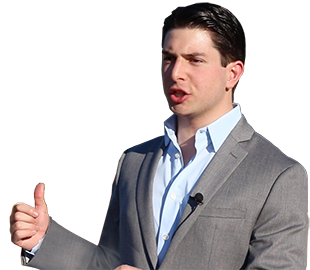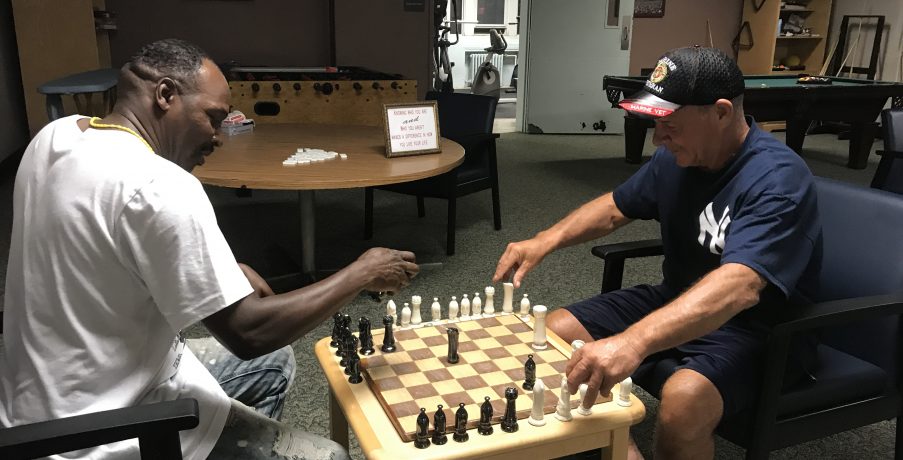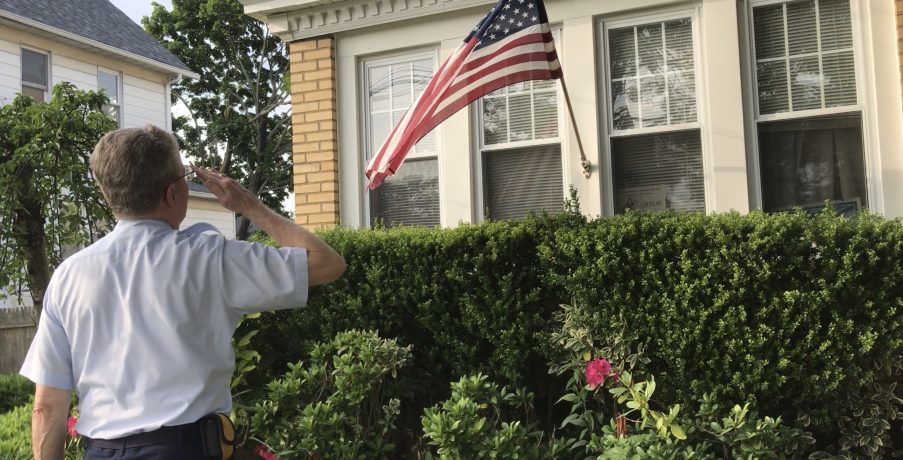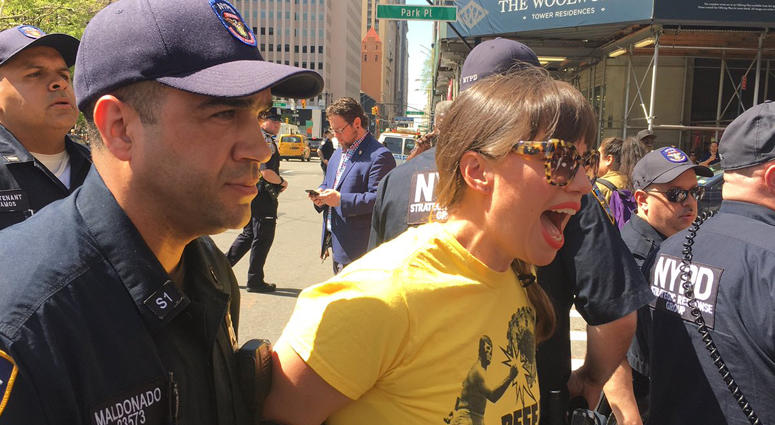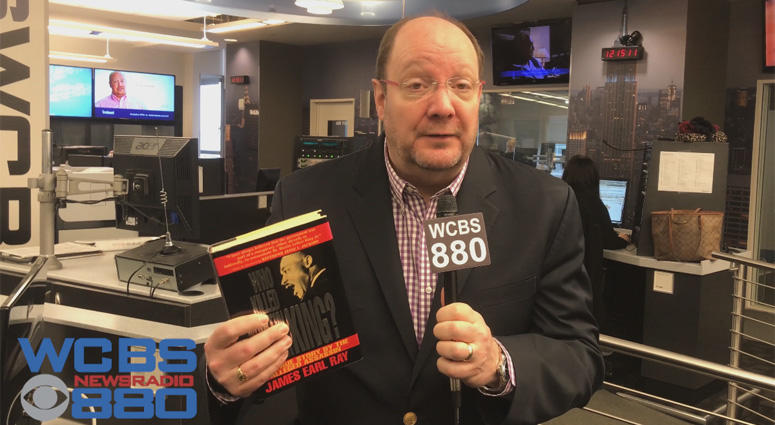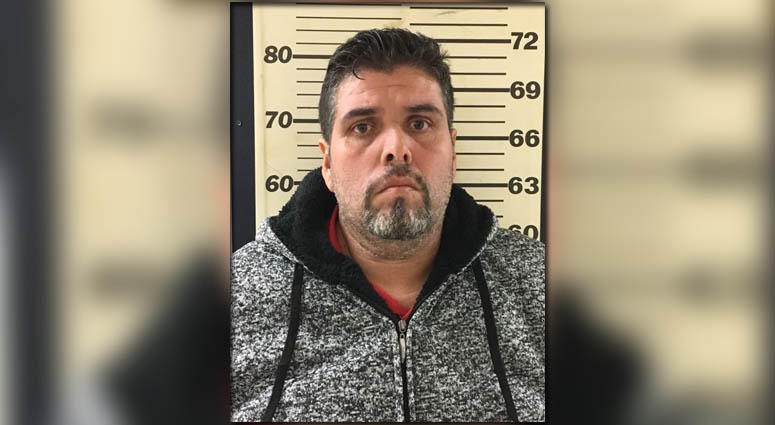
Lee Brice: Garth Brooks is my hero | Kurt's Country
Neil A. Carousso produces NewsNation original “Kurt’s Country” – a celebration of country music and a slice of Americana with host Kurt Bardella.
-
Two Veterans Open Up About The Realities of Service
Post Views: 1,470By Neil A. Carousso, Special to ConnectingVets.com and WCBS Newsradio 880
NORTHPORT, N.Y. — As the sun set on a beautiful Thursday evening at the U.S. Department of Veterans Affairs campus on the North Fork of Long Island, a group of veterans finished their first yoga session and enjoyed dinner together before sitting down in their recreational room to watch the New York Yankees host the Kansas City Royals on television.
It was a light-hearted evening discussing the latest sports news as a distraction for the veterans’ personal struggles since returning home.
“Boot camp was great. I went in at 17. [It] toughened me up to be a man,” said Andrew Brand, a U.S. Marine Corps veteran who served from 1981-83.
Just moments before he offered to speak on camera about his service in the Marines, Brand was passionately discussing New York sports, including his love for the Yankees, Rangers hockey, Knicks and Giants football, and lighting up the room with his larger-than-life personality and friendly jocularity. Then, he turned serious.
“[I] came home on leave prior to going to Beirut and I got in a car accident and I was in a coma for 32 days and I was read my last rights by a priest,” Brand said, continuing, “And, October 23, 1983, they car bombed two barracks, 220 Marines were dead and I would have been there.”
A group called the Islamic Jihad claimed responsibility for the Beirut barracks bombings – a terrorist attack on United States and French service members on a peacekeeping mission during the Lebanese Civil War. It was the deadliest attack against the U.S. Marines since the battle over Iwo Jima in February 1945.
“They’re brothers,” Brand said as he acknowledged he thinks of them often.
Brand is recovering at the Northport VA Hospital from alcoholism. One day, his 14 year old daughter confronted him after returning from a bar and asked him to seek help. He checked himself in at the VA about 8 months ago and he will be returning home to his family in Sayville on Long Island where his daughter and 8 year old son, Andrew, Jr., live.
Brand has kept himself in good shape physically and mentally, exercising daily and eating a healthy and consistent diet as if he was still standing a post – six eggs every morning for breakfast and tuna for lunch and dinner. He is adamant about successfully finishing his recovery and avoiding relapse. As Brand says, “Family first.” Brand has been sober since he checked himself in.
As a Marine, Brand is trained to look out for his cohorts. He shared experiences with Army veteran Donail Sykes who is recovering from a substance abuse issue compounded with PTSD.
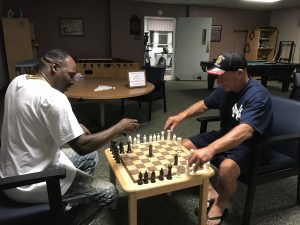
Army Veteran Donail Sykes (left) and Marine Corps Vet Andrew Brand play a game of chess at the Northport VA Medical Center. (Neil A. Carousso/Entercom) “I’m working on it and I’m fighting back and I’m doing well and I’m about to complete this program, but as far as completing the problem I had, it’s a never-ending problem, it’s forever, so I’m working on staying clean every day,” Sykes said.
He is returning home to New Jersey in a few days where he has two supportive brothers and two loving sisters waiting for him, hoping he takes the lessons on stress and coping with PTSD that resonated with him to daily practice when he leaves the VA hospital.
“You know, it’s an every day struggle, but I get through it. I’m getting better now. They give me a lot of training,” said Sykes.
Both veterans said positivity and sharing their experiences with their fellow vets who can relate and understand their tribulations are therapeutic.
“Prayer has helped me a lot,” said Brand who makes it a weekly practice to attend Sunday mass with The Greatest Generation on the other side of the VA campus. He then walks the World War II veterans, many with missing limbs, back to their rooms and spends time talking to them. “It gives me a great feeling inside and they’re very happy that they have someone to talk to and it’s a great experience.”
Each veteran has a story that begins with tremendous sacrifice, and often times, all they need is a welcoming ear to listen.
-
Proud Air Force Vet of 4 Decades Pays Lifelong Homage to the American Flag
Post Views: 1,449By Neil A. Carousso, Special to ConnectingVets.com and WCBS Newsradio 880
VALLEY STREAM, N.Y. — Whenever James Cunningham sees the American flag, he salutes.
Cunningham is a retired senior master sergeant with the U.S. Air Force. His 41 years of service to our nation spans active duty and Air National Guard service.
“I know the history of our country, I know what went into the first flag when it came up, and it’s always been a symbol of our country and the way that we live and I’m proud to be part of that,” Cunningham said.
Congress authorized the United States Flag on June 14, 1777, which is now observed as Flag Day.
The flag was first flown during the American Revolution at Fort Stanwix, on the site of the present city of Rome, New York, on August 3, 1777. It was first under fire for three days later in the Battle of Oriskany.
“I’ve seen a lot of flags and a lot of people who are as proud as I am and I see by the way they display it,” Cunningham said.
When the American Flag is not displayed “properly,” Cunningham politely speaks up because presentation of the flag is essential to the veteran as a representation of our republic.
Recently, Cunningham was going into a restaurant when he noticed the flag on a home next door was “disreputable” because it was in “tatters.”
“When I left the restaurant, I stopped and I rang the doorbell and the homeowner came to the door and I said, ‘Ma’am, I’m sorry to bother you, but I’ve noticed that flag flying there, but it really isn’t a good idea to keep it up the way it is because it’s torn,’” Cunningham said.
Cunningham told the woman that she was “embarrassing” herself by displaying the American flag in such a poor condition. “You’re not giving it the proper respect,” Mr. Cunningham recalled telling her.
She told him that she had a new flag, but she was unable to replace it herself, so Mr. Cunningham put it up for her, replacing the old flag and giving the ripped flag a proper retirement.
“I told her, ‘You can be proud of that flag now and I’m proud that I was able to help you with that,’” Cunningham recalled, with a smile on his face.
When Mr. Cunningham walks in parades with the Knights of Columbus, he marvels at the American flag and salutes the 13 red and white stripes – representing the 13 British colonies that declared independence from Great Britain – and the 50 white stars on the sea of blue that symbolizes the 50 states.
Cunningham lights up when he spots the flag like the solar-powered landscape spotlight that shines on his flag at nighttime from the edge of the bushes on his manicured lawn.
“I salute when I come home,” said Cunningham, whose children used to tease him when they were younger, but now, they understand why he pays his respects to the flag.
As he gazed at Old Glory delicately waving in the breeze in front of his Valley Stream, Long Island home, as the sun set on a beautiful spring Friday evening, Mr. Cunningham turned his head slightly, so he could still see the flag, flashed a smile, and exclaimed, “I’m proud it’s my flag.”
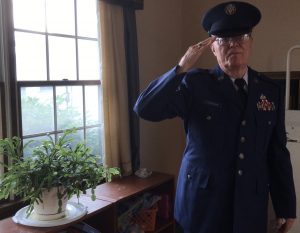
Ret. Sr. Master Sgt. James Cunningham proudly wears his uniform that still fits nearly 23 years after he was discharged. A Life of Service
Cunningham was discharged in July 1995 when he turned 60 years old. His tailor-made Air Force dress uniform still fits today at age 83; he proudly wore it in his Nassau County home, where he started a life with his late wife Mary, eight miles from where he was raised in Queens.
“I wish my wife were here to share this moment with me,” Cunningham said while visibly holding back tears. “We were married for 47 years, we didn’t quite make 50, but she was my inspiration, and as far as the service went, she was with me 100 percent.”
Mr. Cunningham has kept the last rose that was by Mary’s bedside when she passed 10 years ago. He keeps it in a tea cup with “Mary” inscribed in script. A blessing to Mr. Cunningham, the rose has not disintegrated. The rose and tea cup sit atop his living room fireplace adjacent to pictures of his loving family, including his eldest daughter who fell ill from a 9/11-related cancer as she worked on Wall Street and inhaled the smoke that engulfed Lower Manhattan.
Far from despondent, Cunningham is proud, especially of his country that has afforded him a sense of purpose, joy and gratitude. He keeps himself busy with the American Legion and Knights of Columbus organizations, while also serving as an extraordinary minister at the Church of the Blessed Sacrament, which is down the street from Cunningham’s home in Valley Stream.
“My service life endeared me for the rest of my life. It taught me things that came very handy in civilian life,” said Mr. Cunningham.
See more stories at ConnectingVets.com
-
City Council Staffers Get Naloxone Training As Protesters Demand Safe Injection Sites
Post Views: 1,605NEW YORK (WCBS 880) — City Council staffers were trained on how to prevent opioid overdose deaths as protesters staged an act of civil disobedience to get Mayor Bill de Blasio to act on so-called safe injection sites.
City Councilwoman Diana Ayala, who represents the South Bronx, organized the training session, hoping staffers would take the information out into the community.
“It’s a very personal subject matter for me as the family member of several individuals who are drug addicted and who have come close to overdosing,” Ayala said.
#savealife NYC Alliance for Positive Change distributes #NARCAN kits and shows city council members how to use them. @wcbs880 pic.twitter.com/0MnCGsvBnR
— Marla Diamond (@MDiamond8) May 2, 2018
Staffers received training and naloxone kits from Reilly Glasgow with the Alliance for Positive Change who has saved over 50 lives using Narcan at the East Side Harm Reduction Center.
“I say this in joking but I’m jaded, this is something that you do all the time, you don’t even think about it. You just hope you’re not too late,” Glasgow said.
About a dozen arrested including City Councilman Steve Levin for blocking lower Broadway demanding sites where opioid users are monitored. @EndOverdoseNY @wcbs880 #opioidcrisis pic.twitter.com/4kTBSBPQj3
— Marla Diamond (@MDiamond8) May 2, 2018
As the training was held on the 16th floor at 250 Broadway, on street level more than a dozen people, including Brooklyn City Councilman Steven Levine, were arrested for sitting in a crosswalk, blocking traffic near City Hall.
They are demanding that de Blasio release the results of a City Hall-commissioned study on so called “safe consumption sites” where users are monitored.
https://twitter.com/mdiamond8/status/991694382284845061?s=21
“Nobody has ever died of an overdose in a single one of them, you know, we can’t really understand what’s complicated about the best public health intervention for saving lives,” said melissa more is with the drug policy alliance.
“The mayor’s basically saying that it’s complicated, he wants to have everything in a row before he releases the report but while he’s doing that people are still dying,” said Hiawatha Collins with the Harm Reduction Coalition. “At the end of the day it’s not about politics, it’s not about where people are going in their position and elevating themselves, it’s about saving lives.”
Canada and Europe have long had monitored injection sites. There are none in the United States.
Neil A. Carousso produced Marla Diamond’s report for WCBS Newsradio 880.
-
A Look Back at Steve Scott’s Interviews With James Earl Ray, The Man Who Pleaded Guilty To Killing Dr. Martin Luther King Jr.
Post Views: 1,895NEW YORK (WCBS 880) — James Earl Ray pleaded guilty and was sentenced to 99 years in prison in the assassination of Dr. Martin Luther King Jr., which happened 50 years ago Wednesday.
But until his death at the age of 70 in 1998, Ray maintained that the guilty plea notwithstanding, he was not the one who killed Dr. King.
WCBS 880’s Steve Scott interviewed Ray several times – including two radio interviews in the prison where Ray was serving his sentence, first in 1992 and again shortly before Ray died in 1998.
Ray was a footnote in the grand scheme of history, Scott noted. But in 1992, Ray published a book, “Who Killed Martin Luther King? The True Story by the Alleged Assassin.” Upon seeing the book, Scott thought Ray might be an interesting person to talk to.
Scott went through Ray’s publisher to get in contact with him, and not long afterward, Ray called him at home.
“I was taking a nap one day, and got a collect call from a maximum security prison in Nashville, Tennessee, and there was James Earl Ray on the other end of the phone,” Scott said. “And I interviewed him, and then I asked him, I said, ‘Hey listen, if I can get myself down to Nashville, would you be willing to sit down in a room with me and record a radio interview face-to-face talking about the King assassination?’”
Scott said Ray responded, “Well, you know, they don’t like me a whole lot,” but said Scott could ask prison authorities. The prison authorities in turn said there were no rules against an interview, so Scott could come down to talk to Ray if he so desired.
So Scott, who was working in Chicago at the time, headed to Nashville and met with Ray at the Riverbend Maximum Security Prison in Nashville in 1992. Ray laughed as Scott played him a clip of CBS News’ Walter Cronkite from the night Dr. King was assassinated.
“Dr. Martin Luther King, the apostle of nonviolence in the civil rights movement, has been shot to death in Memphis, Tennessee. Police have issued an all-points bulletin for a well-dressed young white man seen running from the scene,” Cronkite said in the clip.
Ray said: “Well-dressed? That couldn’t have been me.”
Ray had been a fugitive from a Missouri prison at the time of the King assassination. He had a long criminal record that included armed robbery, burglary, forgery and unauthorized use of a motor vehicle, CBS News reported.
Speaking to Scott, Ray said he was a low-level crook who ran guns over the Canadian and Mexican borders. He said he was duped into being in Memphis when Dr. King was killed on April 4, 1968.
Ray fled the city shortly after the shooting and was captured in London two months afterward, CBS News recalled. He signed a confession with a detailed description of how investigators claimed the crime happened, and went on to plead guilty, CBS News recalled.
CBS News reported the prosecutor in the case, Phil M. Canale Jr., maintained there was no evidence of a conspiracy in the King assassination. Canale did not outline a motive for the killing, nor did he accuse Ray, who was white, of being racist, CBS News reported.
Ray tried to withdraw the guilty plea three days after issuing it even though he had told the judge he understood the plea could not be appealed, CBS News reported. He claimed at the time that he was set up by a shadowy gun dealer he had met in Montreal and whom he knew only as Raoul, and said he himself was changing a tire at the time King was killed, CBS News reported.
Authorities never found a connection between the man identified as Raoul and the slaying, and several courts said there was never evidence of anyone else’s involvement, CBS News reported.
Ray told Scott in the 1992 interview that he was not involved in any way with the King assassination, and he said he pleaded guilty out of concern that his brother and father – the latter also a prison escapee who had been on the lam for more than four decades – might also face charges otherwise.
Scott: “James, I’ll ask you again, did you kill Martin Luther King?”
Ray: “No, I had nothing to do with the shooting of Martin Luther King, and I had no advance knowledge of it. But having said that, I had been, you know, committing criminal offenses. But I wouldn’t have got no 99 years for what I was doing.”
Scott: “You confessed to the King murder.”
Ray: “Yes… I didn’t really confess to it. I entered a guilty plea. There’s a difference between, you know, a confession and a guilty plea.”
Scott: “But why plead guilty to one of the most notorious murders of the 20th century if you didn’t do it?
Ray: “If I didn’t enter a guilty plea, they might charge my brother Jerry Ray for as a conspirator in the Martin Luther King murder.”
Scott: “Who had nothing to do with it?”
Ray: “He was working. They knew he was working at the time. He was working in Chicago at the time, six days a week. They also said they might arrest my father, and my father, he’d escaped from prison in 1925, and he’d been a fugitive ever since. So apparently, the Justice Department found out about it, and they told my attorney, Percy Foreman, and he came and told me that if I didn’t enter a guilty plea, that you know, they might put him back in jail. And so I agreed to enter a guilty plea on those conditions.”
In the interview, Ray suggested that the FBI was behind the King assassination, because then-Director J. Edgar Hoover was terrified of King’s influence over black America.
Ray also reminded Scott that he was a prison escapee himself in 1968, and said, “What better way to stay under the radar than to kill Martin Luther King?”
The U.S. House Select Committee on Assassinations concluded in 1978 that Ray was the man who killed Dr. King. But the committee concluded that a group of racial bigots in St. Louis – with a reported $50,000 bounty on King’s head, might have been involved too, CBS News reported in 1998.
As to whether he believes Ray was King’s assassination, Scott said: “He maintained until the day he died that he didn’t do it. Do I believe him? I’m not a big conspiracy guy. I’m really not. But there is a lot of compelling evidence – and the King family buys into this as well – that points, perhaps, to the fact that James Earl Ray at least did not act alone or didn’t do it at all. But you know what? If you give me 99 years in prison, I’m going to come up with some pretty good stories too. So the bottom line – I just don’t know.”
Neil A. Carousso produced and edited the backstory video with WCBS Newsradio 880 afternoon anchor Steve Scott.
-
Prosecutor: Mexican Drug King, Alleged Underlings Brought Enough Fentanyl Into NYC To Kill Millions
Post Views: 1,399NEW YORK (WCBS 880) — A Mexican drug kingpin and five others were indicted Tuesday in an alleged drug smuggling conspiracy, which authorities said brought enough fentanyl into New York City to kill 10 million people.
In the indictment filed by the New York City Office of the Special Narcotics Prosecutor, Francisco Quiroz-Zamora, 41 – also known as “Gordo” – was charged with operating as a major trafficker, conspiracy, and criminal sale of a controlled substance.
An indictment alleged Quiroz-Zamora, of the Sinaloa Cartel, was the Mexican-based source of a recent large shipments of fentanyl to New York City, and alleged that
A resident of San José del Cabo, Mexico, Quiroz-Zamora allegedly arranged for narcotics to be smuggled from Mexico to Arizona and California on trucks and cars and with drug couriers. He allegedly communicated directly with New York City drug customers, and arranged for members of his trafficking network to conduct drug deals, prosecutors said.
“Kingpin or major trafficker charges carry a life sentence, and that’s important because he had direct dealings from Mexico with a distribution network in New York City and with an undercover officer, and he was responsible for sending to New York City at least 50 pounds of fentanyl, which is charged in the indictment,” New York City Special Prosecutor Bridget Brennan told WCBS 880 Producer Neil A. Carousso. “And you know, fentanyl is so deadly. It’s viewed to be responsible for what will probably turn out to be a record-breaking number of overdose deaths here in New York City in 2017.”
Quiroz-Zamaroa was charged in connection with a bust that netted 44 pounds of fentanyl at the Umbrella Hotel in the Bronx on June 19 of last year, and on Central Park West on Aug. 4 of last year, prosecutors said.
He received about $22,500 from an undercover officer through a Western Union wire transfer, and came to New York City on Nov. 27 of last year to collect more money from the undercover officer, prosecutors said. But agents tracked Quiroz-Zamora’s movements as he took a circuitous route from Texas to Connecticut by plane, down to Delaware, and then to New York on an Amtrak train, prosecutors said.
Quiroz-Zamora was arrested at Penn Station on Nov. 27 and was originally charged in a complaint in Manhattan Criminal Court. He has been in custody since Nov. 29.
Prosecutors said they also busted a stash house on Central Park West at 105th Street, which was receiving the drugs that were being supplied by the defendants.
“What we found there was it was basically a packaging location; that the people inside that location were packaging many, many thousands of little glassines that were being filled with fentanyl or heroin, and some kind of other substance, and then ultimately, the stuff was headed for street distribution, and that was in a lovely Central Park West apartment with many other people living inside, and when you think about it, it’s a very dangerous situation,” Brennan said.
Five other defendants were also charged in the indictment. Prosecutors alleged that Carlos Ramirez, 27, of Colorado, was caught in a bust with an undercover officer; Jesus Perez-Cabral, 20, maintained the Central Park West drug stash along with Johnny Beltrez, 33; David Rodriguez, 32, was seen carrying suspected narcotics into a car outside the Central Park West building; and Richard Rodriguez, 43, was an Uber driver who drove off with the drugs.
Brennan emphasized that her office is cracking down on fentanyl, with overdoses having reached an all-time high of 1,400 deaths in 2017. Seizures also spiked by a factor of more than 12, from 35 pounds in 2016 to 491 in 2017.
Brennan explained that fentanyl is about 50 times more potent than heroin, and is also cheaper to wholesalers – making dealing in it an attractive proposition for drug traffickers.
“Because it’s a synthetic drug, it’s probably a tenth of the cost of heroin. And so, what we are seeing is that the cartel is sending to the U.S. fentanyl in place of heroin sometimes, or it’s sending up a load that mixes fentanyl with heroin. Heroin being much more expensive, the fentanyl allows them to make a whole lot more money, since when the buyers are buying the little packages in the street, they don’t know whether it contains fentanyl or heroin – it could be either – but they’re going to be paying the same price regardless,” Brennan said. “So it really enhances their ability to make a buck.”
Brennan emphasized that millions could have been killed with the amount of fentanyl the drug traffickers brought to the city.
“Millions, I mean, if they were people who were not tolerant of opioids; who hadn’t been using for some time, it would kill many, many people, because the amount of fentanyl which would kill someone who is not accustomed to any kind of opioid really would fit on the tip of your little finger, so think about it – we seized 400-plus pounds; nearly 500 pounds,” she said. “Think of how much damage that would do.”
Brennan added that her office will be going after everyone in the chain of distribution of such dangerous drugs, but will not stop until finding and prosecuting the top suppliers. She emphasized how dangerous – and how disturbingly commonplace – fentanyl has become.
“Fentanyl is now being mixed in with cocaine. It’s being pressed into counterfeit pills. And so anything on our city’s black market could be tainted with this stuff, and it could kill you. So people have to be very, very careful,” she said. “I think prevention messages are very important. I think people need to become educated and recognize that this stuff can’t be played with.”

